
 |
| 6.4.5 |
Mariculture: Chinook Salmon and Steelhead Trout |
 |
The Feather River Fish Hatchery logo (with permission from the creator, Dennis Blakey) |
| The Feather River Fish Hatchery, in northern California, operates to improve the stocks of Chinook salmon and steelhead trout in the natural environment. This hatchery is operated by the California State Department of Fish and Game under contract with the Department of Water Resources. |
 |
Thermalito Diversion Dam, below Oroville Dam, generates electricity. (GA image) |
| The hatchery was part of the mitigation required in order to build Oroville Dam on the Feather River in California. Oroville Dam was designed in the 1950s and finished about 1967. It produces electricity but, like any dam, it is a barrier to any migrating fish populations. Downstream from this is Thermalito Diversion Dam (shown above) that also produces electricity. The Feather River had large natural populations of both Chinook salmon and steelhead trout – anadromous fish species that begin life in fresh water streams, migrate to the ocean to feed and grow, and then return to their natal stream for reproduction. Although the Feather River had undergone years of environmental degradation by humans since the 1800s (gold mining, logging, and other dams in the watershed) there were still natural populations of migrating Chinook salmon and steelhead trout using this waterway when the Oroville Dam began construction. |
 |
Barrier dam. (GA image) |
| The barrier dam (downstream from the Thermalito Diversion Dam) was built in 1962, prior to the completion of the large Oroville Dam. At this time the two anadromous species (Chinook salmon and steelhead trout), using the Feather River, were already in a state of decline. These fish are unable to pass upstream at the barrier dam. When the barrier dam was constructed a fish ladder was put in so that migrating fish would swim up the fish ladder when they reached the barrier dam. These fish were then trucked above the barrier dam so they could continue their migration and reproduction. When the Oroville Dam was completed (and thus provided a barrier for the anadromous fish), the Feather River Fish Hatchery was built in order to mitigate the effect that the dam has on destroying habitat for anadromous fish. |
 |
Entrance to the fish ladder near the barrier dam. (GA image) |
| Anadromous fish cannot make it across the barrier dam so they enter the fish ladder. The fish ladder has a strong flow of water and many 'steps' that only healthy fish will be able to follow. Anadromous fish will follow the flow of water until they reproduce. Before Oroville Dam was built both Chinook salmon and steelhead trout would travel far above the location of the dam for reproduction. |
 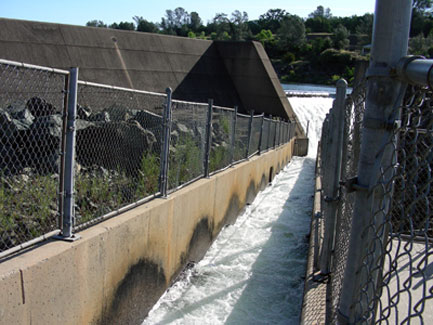 |
Looking up the fish ladder from the level of the Feather River (left). Looking down the fish ladder, toward the barrier dam, from the level of the hatchery (right). (GA images) |
| A fish ladder at the barrier dam is the entrance point of anadromous fish to the hatchery from the Feather River. It is here that both Chinook salmon and steelhead trout, traveling upstream for reproduction, are unable to cross the barrier dam and will, instead, swim up the ladder if they have not already reproduced in the Feather River. |
 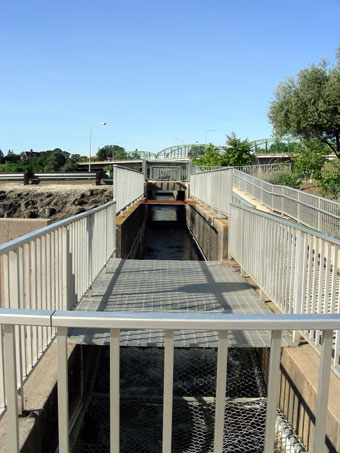 |
Looking down the fish ladder (left). Looking along the channel flowing to the hatchery (right). (GA images) |
| The fish continue to travel 2,000 feet along a channel of flowing water that is coming from the hatchery. The water itself has come from an intake structure, above the Oroville Dam, allowing selection of the depth of water needed for temperature requirements for the downstream hatchery (deeper water is cooler than surface water). This temperature control is a main key in the success of the hatchery as is the hatchery's ability to alter the flow of water in the channel and fish ladder. |
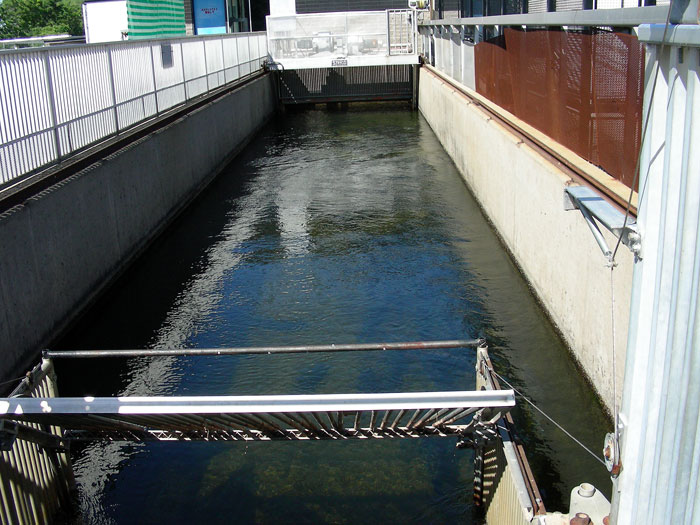 |
Gathering tank. (GA image) |
| At the end of the channel the fish enter a gathering tank. When the hatchery is ready for a spawning event, these fish are swept toward the spawning room (seen at the far end of the tank) and into a large stainless tank inside the spawning room. |
  |
Anesthetizing tank (left). Sorting trays and spawning tub (right) with our guide, John Ford. (GA images) |
| The anesthetizing tank inside the spawning room is filled with water having a small amount of carbon dioxide added. The carbon dioxide replaces the oxygen in the water and acts as a harmless anesthetic to the fish. During the Chinook salmon spawning, workers reach into the tank and grab the fish – first by the tail and then near the gills. The worker then feels the belly of each fish to determine if it is ready to spawn. Chinook salmon that are ready to spawn are killed instantly by an ‘auto kill’ knife that severs the main artery to the brain. (All Chinook salmon die after reproduction but not steelhead trout.) Steelhead trout are not killed and are returned to the river after they have been spawned. The males are separated from the females. The fish are artificially spawned into blue tubs by trained hatchery workers at this time. The orange eggs from the female are mixed with white milt from the male. The milt contains sperm and fertilization is easily accomplished in the blue tubs. The tubs are used to transport the fertilized eggs to the incubation room. |
 |
Round holding tank for "green" fish. (GA image) |
| Fish that have entered the hatchery before they are ready to spawn are allowed to swim to one of four round holding tanks located outside of the spawning building until they are ready to spawn. These fish are called “green.” They quickly revive on their way to the holding tanks. |
 |
Male Chinook salmon ready to spawn. (LJF image) |
| All of the dead and spawned Chinook salmon that were ‘hatchery raised’ are separated. It is easy to tell these fish because the adipose fin is clipped on each one. The heads of these fish are cut off, frozen and sent to the California State Department of Fish and Game where they are thin-sectioned to find the tiny wire that is implanted in a percentage of hatchery raised fish before they are released. The data from this information is compiled and used to help undertand the migratory patterns of the Chinook Salmon. |
 |
Incubation room. (GA image) |
| The fertilized eggs are moved to incubator trays in the incubation room. Feather River water is supplied to the incubator trays through the pipes running along the top of the incubators. All the fertilized eggs that remain at the Feather River Fish Hatchery will imprint on Feather River water and return there to spawn. It is a rare event that fish from another hatchery are found. |
 |
Incubator Tray. (GA image) |
| The fertilized eggs are flaccid at first, then within a short period of time they are ‘water hardened’ and introduced into incubator trays with two layers of screen and given an iodine treatment to get rid of any fungus. Each tray holds about 10,000 eggs. They are kept about two and a half months in these incubator trays all the while being bathed in 45 to 48 degree Feather River water. |
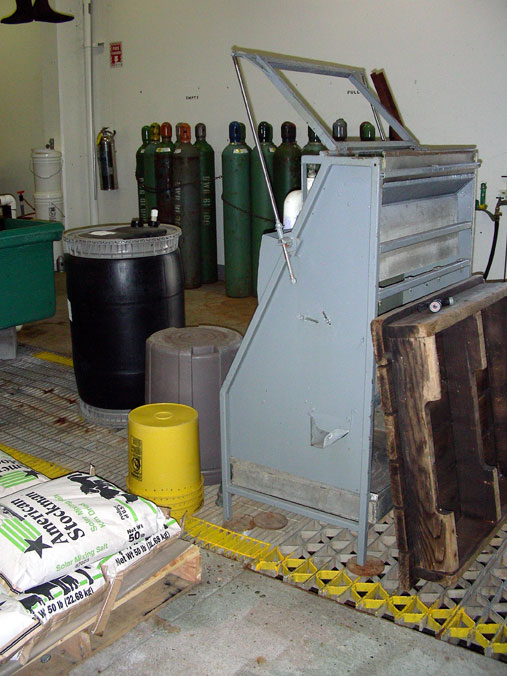 |
Bouncing Device. (GA image) |
| Several procedures are used on the developing eggs to insure that any weakened eggs are removed. The eggs may be ‘adeled’ at 28-30 days (this is the 'eyed' stage) – by a hard spray with water to kill the weak eggs and remove any undeveloping eggs. The eggs may be ‘bounced’ in a type of sorting device. Eggs that have died do not bounce. The bouncing device allows the separation of live and dead eggs. A one ounce beaker is used to take a sampling of eggs to be placed on a wooden board to get an accurate count of the number of eggs per ounce. This value is used for the ‘quota.’ By the end of the three month spawning season there may have been 20,000 salmon harvested (generally half male and half female) with 17,000,000 eggs starting the hatchery process, 13,000,000 after adeling, and yielding 11-12,000,000 baby salmon per year – depending on the quota. |
   |
Diagrams of a fertilized egg (left), 30 days of development (middle) and 60 days of development (right) from an interpretive sign at the hatchery. |
| The fertilized eggs take about three months to develop. Ten hours after fertilization the fertilized egg becomes turgid and begins development of the embryo at the germinal disk with the yolk supplying the food. After 30 days the eyes are visible and after 60 days the baby discards the egg shell but still has food from the yolk sac. They are called alevin, or fry, at this stage. When the yolk has completely disappeared (another 30 days) the babies are ready for the rearing ponds. |
 |
Young, hatchery raised, steel head trout. (GA image) |
| The hatchery raised babies are transferred to rearing ponds/raceways when the yolk has disappeared. |
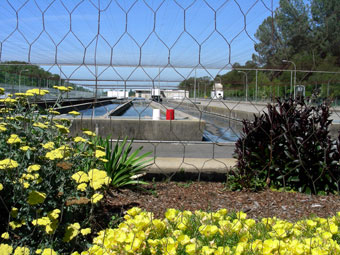  |
Rearing ponds/raceways (left) and young Chinook salmon in a rearing pond/raceway (right). (GA images) |
| The baby fish are kept in rearing ponds/raceways until they are ready for release. Steelhead are kept for one year and Chinook salmon are kept until they reach about 90 fish per pound. This pond area is covered to prevent natural predators (birds, raccoons) from eating the baby fish. |
 |
Tagging trailor on the rearing ponds/raceways. (GA image) |
| A percentage of the hatchery raised salmon are ‘tagged’ by clipping the adipose fin and implanting an identification wire into their nose area. This is accomplished by a 'tagging trailor' that runs along the rearing ponds/raceways. |
  |
Chinook salmon (left) and tagged Chinook salmon (right). (LJF images) |
| Looking at the adipose fin area it is easy to identify hatchery raised Chinook salmon from the wild population. The wild population of Chinook salmon has an adipose fin. All tagged Chinook salmon from the hatchery have their adipose fin clipped. |
 |
Trucks to transport hatchery raised fish to the wild. (GA image) |
| The baby fish are trucked for release in special trucks with refrigeration and oxygenation to keep the baby fish healthy. The steelhead are often released in the Feather River or Sacramento River and the Chinook salmon are often released somewhere in the San Francisco Bay/Delta where the water is brackish. The fish migrate under the Golden Gate Bridge and live for the next 2-3 years in the Pacific Ocean. These same fish will return through San Francisco Bay, up the Sacramento River to the Feather River and either reproduce naturally before getting to the hatchery or be captured at the hatchery and artificially spawned. |
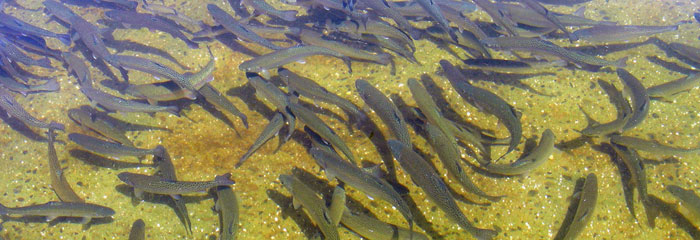 |
Hatchery raised Chinook salmon. (GA image) |
| An assessment of the population of fish in the Feather River began to show too many hatchery raised fish returning to spawn. With worries that these might outcompete the wild population in the Feather River, the California State Department of Fish and Game (with input from the National Marine Fisheries) put goals and constraints on the Feather River Fish Hatchery. While there are contraints to controll the production of salmon at the hatchery, a program to limit the numbers helps insure a successful goal at maintaining the anadromous run on the Feather River. |
 |
Fishermen on the Feather River. (GA image) |
| The success of the Feather River Fish Hatchery is a win/win situation. Oroville Dam provides electrical energy, water supply and flood controll. The Feather River Fish Hatchery assures that the anadromous fish populations are maintained. The dead salmon (after being spawned at the hatchery) are still edible but not high quality. They are either distributed to local native Americans as fresh fish or by ‘gleaners’ working with local Community Action Agencies. |
| A large part of this success is due to the design of the Oroville Dam Project which allows for the control of the temperature of the water that is released downstream to meet the operational needs of the Feather River Fish Hatchery (fish ladder, incubation process, and rearing ponds). There are several anadromous fish hatcheries in California but the Feather River Fish Hatchery is one of the most successful. Thanks to John Ford, for giving me a wonderful and informative tour of the hatchery and answering all of my questions to make this lesson possible. |
(Revised 6 August 2007) |